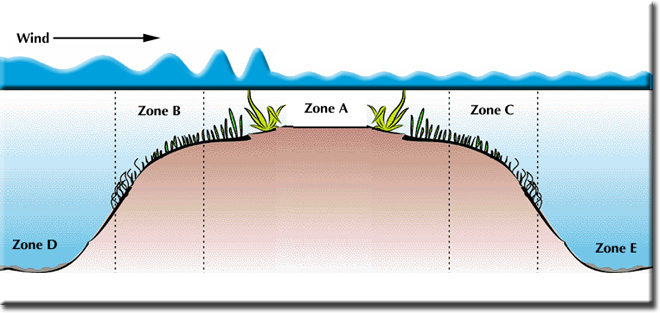Wind Consideration: If the Smallmouth Bass are feeding aggressively they will be on the windy side of the shoal. If this is the case, one of techniques described for Zones A, B & D should be effective.
Zone A: When you reach casting distance of the shoal the first thing you should do is cast small shallow running lures such as floating linear and floating jointed Rapalas and Thundersticks or whatever shallow lures you have. Keep trying different colors from bright colors like red, fire-tiger and chartreuse. If this does not work try casting more natural colors such as silver-&-black, gold-&-silver, blue-&-silver. If you are catching good size bass than keep going. If not, try Zone B.
Zone B: Cast lures and colors just like Zone A but use deeper running lures such as Fatraps, Cotton Cordells, buzzbaits and even small spinnerbaits. If that's where you are hitting good size bass then keep doing it. If you are not hitting them then try Zone D.
Zone D: If the bass are in Zone D this means they are aggressively feeding but choose to stay deep. This may be caused by too much wave action, dropping pressure, too much light penetration or maybe they followed a school of minnows down deeper. In this case you want to try dropping tub jigs that have a little bit of worm stuffed in them or regular jigs tipped with a leech, minnow or a salted rubber. Scented rubbers do not work in the north. It's best to use salted baits or unscented rubbers. Try a whole range of colors. If you start hitting bass then keep doing it. If you don't have any luck then Zone's C and E must be where they are.
Zone C & E: If the Smallmouth Bass are on the quiet side of the shoal that means they are not feeding aggressively. This is when you go to live bait. For Zone C, put a minnow, leech or big juicy worm on a size-5 bass hook with no weight and cast into the zone and slowly drag the bait over the rocks. If a bass grabs the bait release your bail and let him take some line for about 5 seconds before you set the hook. You don't want to set the hook right away and you also do not want the bass to swallow the hook. The 5-second rule seems to be the safest for the fish.
If you are not getting any action in Zone C then cast out over the deeper water of Zone E and just let the bait slowly sink. Let it sink right to the bottom and site there. If the Smallmouth Bass are there they see it and know it's there. If you do not get a bite pull the bait towards you about a foot an let it sit back down on the bottom.
The methods above work for any structure. On days when it's dead calm and there is no wind at all, you might have to try all six styles on all sides of the shoals. Usually when it's dead calm the Smallmouth Bass are right up in the shallow water and can be taken with shallow running lures. You can also try casting Crawler Harnesses, small Mepps Bucktails or the Mepps spinner with the rubber minnow hook. You can also try surface lures such as Jitterbugs, Bass Poppers and Heddon Spooks. Be aware that surface lures will attract Northern Pike. They can steal your lure if you don't have a steel leader on. Also, if a big Northern Pike moves into the area the bass will stop feeding. If you are not catching bass put on a Daredevle and try picking off some northerns.




